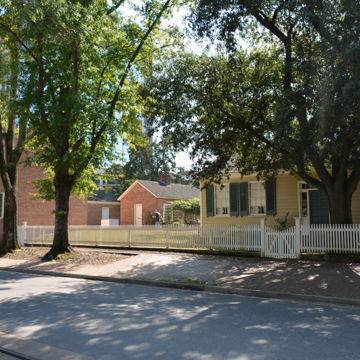This historic site museum was created by an act of the Arkansas legislature in 1939. It was the culmination of a one-woman campaign led by Louise Loughborough, who fought to preserve and restore four early-nineteenth-century buildings on this block: the Hinderliter Grog Shop, the McVicar House, the Brownlee House, and the Arkansas Gazette print shop (also known as the Woodruff Print Shop). The Arkansas Territorial Restoration (ATR) opened to the public in July 1941. By the 1970s what had started as a simple restoration project (Max F. Mayer was the restoration architect) was evolving into a full-scale museum. In 1981, the ATR became the state’s first history museum accredited by the American Association of Museums. A major expansion that began in 1996 culminated in 2001 with the opening of the fifty-thousand-square-foot museum building, featuring exhibition space, a performance theater, and an education and research wing. At the same time, the name of the museum was changed from the Arkansas Territorial Restoration to Historic Arkansas Museum to more accurately reflect the museum’s purpose. In addition to the museum center, the grounds contain the four buildings from the original Territorial Restoration, along with the Plum Bayou Log House, a c. 1830s dogtrot moved to the site from Scott in 1976. As well as guided tours, the museum offers a living history program and an outstanding collection of Arkansas-made decorative, mechanical, and fine arts objects.
The oldest building on the site is the Hinderliter Grog Shop (c. 1827) built by Jesse Hinderliter, who occupied the house along with his wife Sophia and two slaves until his death in 1834. The ground floor accommodated a tavern, and Hinderlater and his wife lived on the upper floor. The building is constructed of hand-hewn oak logs, which were covered with cypress siding in 1834. It is Little Rock’s only surviving wooden structure predating statehood. It is also commonly associated with the last meeting of the territorial legislature of 1835. The Hinderliter Grog Shop is generally viewed as the most significant historic building on the grounds of the Historic Arkansas Museum.
Scottish stonemason Robert Brownlee, who came to Little Rock in 1837 to work on the construction of the Old State House, built the James and Isabelle Brownlee House (c. 1848) for his brother and sister-in-law, who, along with their slave, Tabby, resided in the house until 1852. The Federal-style brick house features a wide veranda across the back, a common feature on southern homes from the period. Robert Brownlee had the wooden mantels in the parlor and bedroom marbleized to add a more refined look to the interior. In 1849 he left for the California gold rush with his friend James McVicar, who was then serving as the director of the state penitentiary. The pair formed and led the Little Rock–California Company to the California Gold Rush. In c. 1848, James McVicar had built a dogtrot house of white oak logs joined with square pegs. Sheathed in clapboard siding, the open central passage was later enclosed. William Woodruff’s brick two-story house and print shop of 1823 (mistakenly demolished in 1939) was reconstructed by Ruby Architects and includes a replica of the press.


